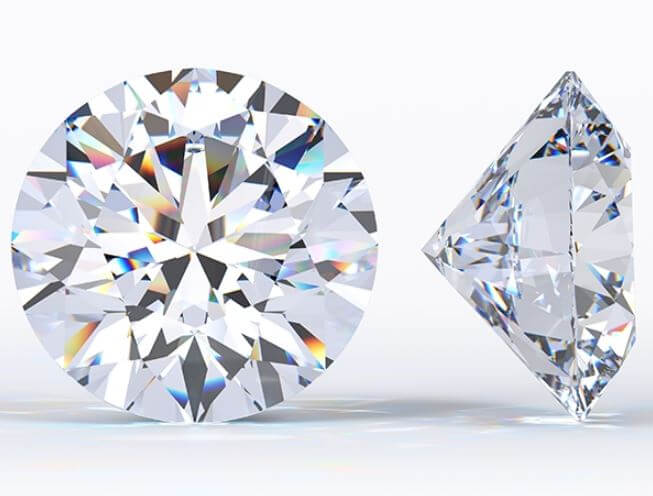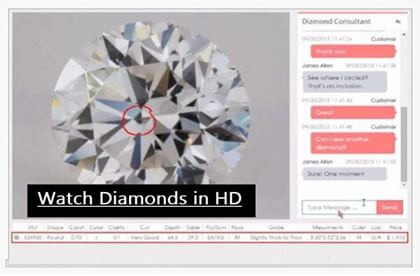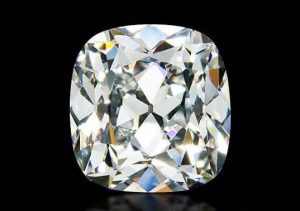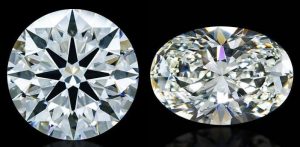Executive Summary
The cut of a diamond has a more direct impact on the appearance of the diamond, it determines the brilliance and sparkle of a diamond. When buying a diamond, you have to determine first if it has the right sparkle, if it is not cut too shallow or too deep. When a diamond is very well cut to its appropriate proportions, the diamond reflects light a lot and gives a very brilliance sparkle. The cut grade of diamonds has 5 different levels (excellent, very good, good, fair, and poor) based on how well or poorly a diamond is cut.
Diamond clarity is a measure of the number of impurities that can be found in and on a diamond. It has become a standard for measuring the physical appearance of a diamond, whether it is good or bad. The higher a diamond is on the clarity scale, the lesser the impurities and inclusion that the diamond has, and the more valuable the diamond is and vice versa.
The cut and clarity of a diamond are both means by which the value of a diamond is evaluated. The higher a diamond is on the clarity scale, the higher the value of the diamond. Diamonds with excellent cut are usually more expensive than diamonds with very good cut etc.
When buying a diamond, your priority should first be on the diamond cut before the diamond clarity. If you want a very beautiful and sparkling diamond, you should focus on the cut rather than the clarity. A diamond’s poor clarity can negatively affect the sparkle of a diamond. The impurity in the diamond would block the reflection of the light and it will reduce the diamond’s sparkle. You can save money on diamond clarity by compromising on the highest grade and being circumspect but you should not compromise on the cut of a diamond.
Diamond cut and clarity are two very important components for grading or evaluating a diamond.
Diamond clarity is a measure of the number of impurities that can be found in and on a diamond. It has become a standard for measuring the physical appearance of a diamond, whether it is good or bad. The value of a diamond can be determined by the clarity of the diamond. The higher a diamond is on the clarity scale, the lesser the impurities and inclusion that the diamond has, and the more valuable the diamond is. The lesser a diamond is on the clarity scale, the more impurities and inclusions the diamond has, and the less valuable the diamond is.
There are different degrees of inclusions which is actually what the clarity scale typifies. Diamonds are not included in the same way. There are some inclusions and blemishes that are not visible to the human eye and would require the expertise of a gemologist to point out, while there are others that are obviously visible even to the unaided eye and does not require any expert help or knowledge.
The cut of a diamond has a more direct impact on the appearance of the diamond, it determines the brilliance and sparkle of a diamond. If you seem to have come across a diamond that is so beautiful and very scintillating, then you have come across a diamond with an excellent cut. When buying a diamond, you have to determine first if it has the right sparkle, if it is not cut too shallow or too deep. When a diamond is very well cut to its appropriate proportions, the diamond reflects light a lot and gives a very brilliance sparkle.
There are various levels of diamond-cut as well and this is also what the cut grade typifies. The cut grade has 5 different levels (excellent, very good, good, fair, and poor) based on how well or poorly a diamond is cut. A diamond cut is also a measure for evaluating the value of the diamond. Diamonds with excellent cut are usually the most expensive while a diamond with a poor cut is the least expensive.
Buying tips – cut or clarity which is more important
Clarity:
Without a doubt, the clarity of a diamond can go a long way to affect the sparkle of the diamond. When a diamond has a low clarity grade, the diamond does not sparkle as much as you would want it to but when the diamond has a high clarity grade, it tends to sparkle a lot more. This is because of the impurities found in and on the diamond blocking the fire and sparkle of the diamond. So diamonds with little or no impurity will sparkle more without restriction. This fact has made many people overpay for diamond clarity. Many even exceed their budget simply because they want a sparkling diamond. But that is best defined as a misplacement of priority.
If you want a sparkling diamond, your focus should be on the cut of the diamond and not its clarity. Clarity should, in fact, be one of the last factors to consider as far as the 4cs are concerned. You can save a huge amount of money on diamond clarity than diamond cut, so it should not be your priority. You can actually get your preferred diamond size with a perfect cut, the right setting, without any flaws visible to the naked eye, and you are not overpaying for it.
You would have noticed from the clarity scale that from the highest grade, which is FL, all the way down to SI1 at least, all the diamonds that fall in these categories do not have impurities visible to the naked eye. Even some SI2 diamonds do not have impurities that are visible to the eyes. For a diamond to be beautiful, it does not have to be flawless. All you need is for the diamond to be eye-clean. An SI1 diamond is sold for a fraction of the price of an FL diamond but they appear the same way to the naked eye. So you do not want to major too much on the clarity of a diamond, raising the bar so high. This will only incur a very expensive and unnecessary expense.
To buttress how much money you can save on diamond clarity and how it should not be your utmost priority, you can actually go-ahead to purchase a diamond that has impurities in them. As long as you take note and pay attention to certain things, this would not be a big deal. It is as well a way of cutting down the cost of your diamond purchase. This works best for people with a restricted budget. The following tips are important if you are to purchase a diamond with impurities in them;
- Inclusions that are well spread are usually less noticeable. So if you are going for an included diamond, make sure that they are not concentrated or form a cloud at a point. This makes them more visible, especially if they are at the center.
- Avoid diamonds that have their inclusions at the center. They are more noticeable. If you would be buying an included diamond, make sure that the inclusions are at the edges of the diamond, not the center. At the edges, the inclusions are not easily noticeable and they can as well be masked by the setting you place the diamond in. In the end, the inclusion would not be seen but you would have bought the diamond at a relatively cheap price.
Cut:
The beauty of a diamond lies primarily with the cut of the diamond. The cut of a diamond has three main attributes; brilliance (the total amount of light reflected by the diamond), fire (spectacularly beautiful colors flashing all over the different parts of the diamond) and scintillation (the diamond’s sparkle or flashes of light from the diamond). All of these attributes when put together determine the beauty of the diamond. Inclusions in the diamond may affect the diamond’s sparkle but that is not enough reason to prioritize clarity over the diamond cut. It is beyond the SI1 grade that inclusions in a diamond become noticeable, so there is a lot of room for flexibility with diamond clarity. But if a diamond is not cut to the right proportions, it affects the diamonds in different ways, even the color and clarity of the diamond will be affected. So this leaves little or no room for flexibility when it involves the cut of a diamond.
When a diamond is well cut, the diamond is able to disperse light, like a prism, into a rainbow of different beautiful colors. The light performance of a diamond is determined by how well cut the diamond is. When a diamond is poorly cut, it is not able to disperse light properly. The diamond will appear dull (depending on how poorly it is cut), the normal brilliance and sparkle that you would expect from a diamond would not be there.
If you compare all the 4Cs, you will realize that it is only the diamond cut that determines the overall appearance of the diamond. Carat weight is restricted to size, color is restricted to the diamond’s color and clarity is restricted to the presence or absence and visibility or invisibility of inclusions in diamonds. But the diamond cut actually determines the diamond’s overall outlook and can as well affect all other members of the esteemed 4Cs of diamond. If a diamond has a poor cut, it is unlikely that it does not have very noticeable inclusions in them. As a matter of fact, no matter how high a diamond clarity is, the diamond is practically useless if it has a poor cut. The same goes for color. The colorlessness of a diamond is a waste if it is poorly cut. On the other hand, if you find a diamond with a perfect cut, it can compensate for clarity and even color, so you can go further down both scales. With a perfectly cut diamond, you can decide to settle for clarity of SI1 or SI2 comfortably and even color of G – H. As long as the cut is perfect, it can make up for the others. The diamond would still appear very beautiful because of its superb ability to create brilliance and sparkle due to its perfect cut.
Another advantage of giving a premium to diamond cut is that it can save you some cost with clarity and color. The fact that you can settle for an SI1 or SI2 clarity grade means that you can save some more money on clarity. Similarly to this, is the diamond color, being able to settle for a color grade of G – H goes a long way in helping you save some money. That is how important the diamond cut is.
The diamond cut is unequivocally the most important of all the 4Cs and it is therefore deserving of more attention when the choice of what diamond to buy is on the table.




